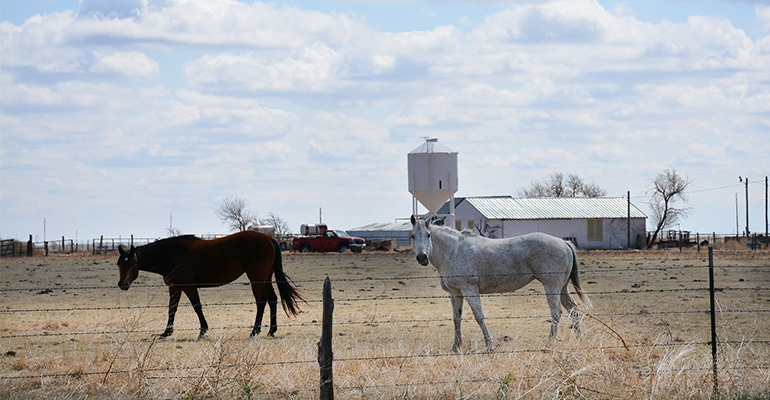
In February, a small number of wild horses and burros were trucked into an auction house in Hallettsville, Texas, and offered to buyers with the stipulation they understood the animals have never been domesticated and were gathered from free roaming herds across U.S. Western states.
About 40 equine in all were offered at auction in Hallettsville, a town of about 2,800 located between San Antonio and Houston. Only 24 of those were placed (adopted) to new owners, a small number considering the significant population of wild equine in the U.S. are either scheduled for or already have been removed from federal range land in recent times.
According to the Bureau of Land Management (BLM), the lead agency charged with managing the wild horse and burro problem, the animals need to be relocated because wild equine populations have soared in recent years, and productive forage acres have diminished on the federal lands in the Western States where these animals roam freely.
BLM is the federal agency charged with both protecting the animals and maintaining healthy, federal lands. They are the guardians of an estimated 73,000 wild horses and burros that roam across the 26.9 million acres located within 177 total herd management areas across the 10 Western states.
BLM argues says, based upon scientific data, the land within these herd management areas are capable of providing adequate forage to only about 25,000 free-roaming equine, and this is why a systematic program of removal is necessary. While a number of the animals that are removed are placed up for adoption, in truth only a small percentage find a new home. The others remain in a BLM holding facility where they are cared for and fed, a task that BLM argues is taxing their budget.
The issue has fueled debate among horse lovers, lawmakers, BLM officials, activist groups, and others across the nation about how to address the problem. Since 1971, BLM has been charged with maintaining and cultivating these symbols of the American dream. But as horse and burro populations began a period of rapid growth once the animals were declared protected on federal land, the number of animals that need to be relocated have increased substantially. So far, BLM estimates it has removed and relocated over 240,000 wild horses and burros and over 50,000 more should be removed to protect and preserve healthy forage acres.
Activist note that while slaughtering of horses in the U.S. is no longer allowed, "kill-buyers" at BLM auctions have often purchased horses at low costs just to ship them to slaughterhouses in Mexico and Canada for a profit, an unfitting end, especially to such an American icon.
BLM says they do not offer equine at auction or place them with organizations without a vetting process and argues many of their partners in the relocation process are non-profit animal rescue groups.
But the agency says population control is required from a wildlife management standpoint. The equine compete with other wildlife that require grazing lands including deer, elk, bison and antelope. They also say protecting forage in these grazing areas is required for the benefit and protection of all the animal species that rely on these areas for survival.
Some activist groups, however, have charged the federal agency with giving in to powerful beef industry lobbying groups who they say are motivated by the industry’s need to continue an aggressive program of leasing much of these unspoiled grazing acres. They argue by reducing wild horse and burro herds, it leaves more productive grazing acres open for lease to cattle producers, an allegation federal officials dismiss as untrue.
The Bureau of Land Management created the Wild Horse and Burro Program to implement the Wild-Free Roaming Horses and Burros Act, passed by Congress in 1971. Broadly, the law declares wild horses and burros to be “living symbols of the historic and pioneer spirit of the West” and stipulates that the BLM and the U.S. Forest Service have the responsibility to manage and protect herds in their respective jurisdictions.
Pat Williams, the state lead for the New Mexico Region Wild Horse and Burro Program, was on hand in Hallettsville, as he is at many BLM auctions across the Southwest. He said wild horses primarily roam in Nevada, Utah and Northern California while the largest burro herds come from Southern California and Arizona. He warns that while the program is designed to protect and preserve these historic symbols of American history, it also charges BLM with helping herds to maintain their health.
When there is not enough food or water to sustain a herd, animals can quickly become sick or weak, and subsequently suffer. Williams says it is both respectful and compassionate to prevent or minimize the suffering these animals endure as a result of poor herd management.
While rounding up the animals and trying to auction them off is necessary, it's also an expensive program to support. It takes about nine football fields of native vegetation to feed one wild horse for a week, BLM officials note. Once animals are removed from the range, the cost of supplemental feeds and health care become an issue of burden on the government.
The issue has put activists, landowners, naturalists, ranchers, government officials and animal welfare groups at odds in recent years, each making their arguments, none, perhaps, offering a better solution. However you look at it, and regardless your take on the issue, there's little doubt that it is an emotional firestorm for everyone on both sides of the issue.
Because of its explosive nature, the issue will no doubt continue to be debated strongly by supporters and opponents to the relocation issue. BLM says they continue their policy of removal and relocation in hopes that more people will consider adopting one of these animals. Williams says while he suspects there will always be more animals than people willing to adopt them, he believes every adoption helps the cause of these noble creatures.
About the Author(s)
You May Also Like




